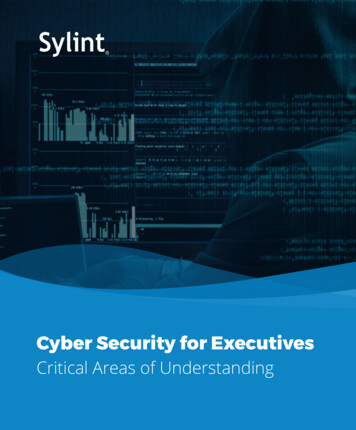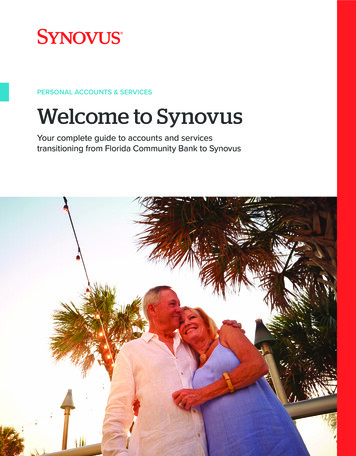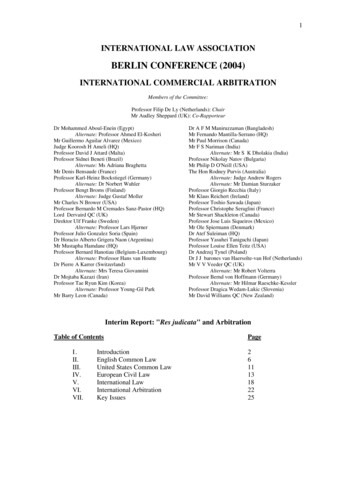
Transcription
Sylint Cyber Security for ExecutivesCritical Areas of Understanding
1What is Cyber Security?2Why is Cyber Security relevantto us? Our organization’sinformation is public anyway.3Is Cyber Security an InformationTechnology problem or anEnterprise Risk?4Who is behind cyber attacksand data breaches?9If “patches” can fix software,operating systems and applicationsvulnerabilities, why are maliciousactors still successful in exploitinginformation and operating systems?10What is the probability of anorganization getting breached?11Is it possible to securean entire network?12What should my securitypriorities be?13What considerations shouldbe given to critical assetsand information?5What motivates malicious actorsto conduct cyber attacks?6What is attribution and whyis it difficult?7We have strong network perimeterdefenses. Isn’t this enough?14How can information be impactedby a Cyber Security event?8Why are there so many securityvulnerabilities in software,operating systems andapplications?15Which information securitycategory typically has thehighest impact potential?16How can malicious actorspenetrate an organization’snetwork and operateundetected?Sylint.com Sylint - 25 Cyber Security Questions Copyright 2020 Sylint Group, Inc. All rights reserved.2
17What is IAM and why isit so important?18Why are passwords notalways effective?19What is multifactorauthentication (MFA)?20What is encryption?21What is meant by “data-at-rest”or “data-in-transit”?22Why aren't AI and BehavioralAnalytics sufficient?23Why should non-IT executivesbe aware of Cyber Securitymeasures?24Why would non-IT executivesbe part of a Cyber Securityincident response?25What are the potentialrepercussions of a data breach?Sylint.com Sylint - 25 Cyber Security Questions Copyright 2020 Sylint Group, Inc. All rights reserved.3
What is Cyber Security?Conceptually, Cyber Security encompasses, “measures taken to protecta computer or network of computers against unauthorized accessor attack.” In the physical world, this is the community gate guard,the locks on the doors and the exterior and interior walls in the house.Our organization’s information is public.Why is Cyber Security relevant to us?Attackers are also looking to disrupt operations and charge money torestore systems (e.g., ransomware), steal resources (e.g., computerprocessor power) to mine crypto-currency, disguise attacks againstother companies, or just spread their message. Also, most organizationsare in possession of information regarding operations, employees,clients, contributors, students or business associates that may be offuture value to others.Is Cyber Security an Information Technologyproblem or an Enterprise Risk?Cyber Security is an Enterprise Risk. Much of the data is outside IT’s directcontrol, and business operations determine the ability to implement andmaintain security controls. While the locksmith can put a better lock ona door, that doesn't mean the business will let them (or that they evenknow the door exists). Enterprise Risk covers items with a significantimpact on operations and potentially impacts the overall survivability ofthe organization.Who is behind cyber attacksand breaches of information security?Actors behind cyber attacks typically fit into one of four categories:1. Nation States & Terrorist Organizations2. Organized Crime and other Criminals3. Hacktivists4. Industrial EspionageAs time progresses, lines between the categories have begun to blurbased on available tools, attacker sophistication and information sharingbetween groups. Once a tool is developed and released "into the wild"it is available for anyone to wield, and attackers frequently draw fromthe same "pool" of tools in conducting their attacks.Sylint.com Sylint - 25 Cyber Security Questions Copyright 2020 Sylint Group, Inc. All rights reserved.4
What motivates malicious actorsto conduct cyber attacks?Nation States seek information to promote political, economic and military advantages. Their focus istypically strategic and they perform significant research on select targets. Their operations are usuallylong term in nature. Some Nation States have also begun using cyber attacks to self-finance theiroperations through activities normally seen in Industrial Espionage and Organized Criminal realms(e.g., ransomware, crypto-currency mining). Since they draw tools from the same 'pool' as everyone else,telling the difference between threat actors can be difficult.Terrorists seek to promote uncertainty in thephysical world and to enhance support oftheir stated objective or cause. Currently,terrorist organizations use cyber operationsfor command and control of their worldwideterrorist cells, to help fund and spreadpropaganda regarding their ideology, and torecruit membership into their terroristorganization. A terrorist may also covertly usethird party cyber assets to obfuscate theirlocation and operations.Organized Crime groups seek financial benefitsusing the cyber domain as an additional meansto support illegal operations and criminal activitywhile shielding their identity. Their focus isusually short term and potential victims includea wide range of targets that exhibit knownCyber Security vulnerabilities. They may useinnocent third-parties to help shield theiroperations, and frequently use informationfrom past victims to launch attacks againstassociated companies. These crime groupsoften operate as professional organizationswith management and leadership structuresand different business units charged withspecific responsibilities (e.g., research, attack,reconnaissance, and monetization).Hacktivists seek notoriety for social causes,such as their perception of animal rights orgovernment inequities. Hacktivists typicallytarget select entities with the objective ofobtaining the maximum amount of publicityin hopes of generating additional support fortheir cause and to ruin the public perceptionand reputation of their target.Industrial Espionage can take the form ofsmall-scale insider threats or sophisticatedoperations with the backing of a NationState. These actors work to shorten research &development cycles and increase profitability bystealing and leveraging someone else's work.Sylint.com Sylint - 25 Cyber Security Questions Copyright 2020 Sylint Group, Inc. All rights reserved.5
What is attribution and why is it difficult?Attribution is the act of relating a cyber attack to a particular group or individual.This is frequently based on comparisons of similarities in malicious code(malware), language, attack techniques, origin and other digital "fingerprints".However, these fingerprints are often masked by: Bouncing digital communications through commercial Virtual PrivateNetwork (VPN) companies or through a distributed network of relaysoperated by volunteers all around the world (i.e., TOR) Using otherwise innocent victims as launch points, and Using attack tools and techniques commonly associatedwith a different threat actor.Nation States are particularly adept at using these techniques to maintain"plausible deniability" while conducting their operations. Organized Crimegroups may be easier to identify, but use privacy laws, internationalregulations, and even their home-country's complicity to maintainoperations. Ultimately, threat actors are drawing their tools and techniquesfrom the same "pool" and it can be difficult to specifically identify who isbehind the mask without a lot of cooperation and joint investigation.We have strong network perimeter defenses.Isn’t this enough?Similar to early military defensive measures, initial stages of Cyber Securityfocused solely on perimeter defense. Employing a castle structure aroundthe King’s residence provided some measure of protection; however,attackers eventually discovered methods to breach that perimeter (or waiteduntil the King left) necessitating the concept of layered defenses. Just like interiordoors & walls, locks & video cameras, and emergency generators& fire departments, secondary and tertiary cyber security controls provideadditional opportunities for both detection and defense. Many times, outboundcontrols (e.g., web proxies & DNS protections) are as, or even more, important asinbound controls. Asking the question, "what happens if someone gets past thatcontrol" is an important part of understanding cyber security risks.Why are there so many security vulnerabilities insoftware, operating systems and applications?Much like building a house, systems required to integrate with each otherleave gaps through which attacks can occur. Software development is not aperfect process, and is generally measured around operability instead ofsecurity. A house without windows and doors is more secure, but not veryfunctional. Single-source systems (e.g., Apple) tend to have fewer issuesbecause of this tight integration between hardware and software.Sylint.com Sylint - 25 Cyber Security Questions Copyright 2020 Sylint Group, Inc. All rights reserved.6
If “patches” can fix known software, operating systems andapplications vulnerabilities, why are malicious actors stillsuccessful in exploiting information and operating systems?Patching is hard. Complex network enterprises have interconnected systems that are fragile in nature.Even with automatic patch processes, updates have the potential to induce a corresponding systemfailure that dramatically impacts operations, and the business unit (not IT) may be unwilling to takethat operational risk. Even where patching is possible, IT staff generally test patches in a nonproductionnetwork prior to installing on operational systems to reduce the likelihood of patch-induced issues.All of these delay patch installation, and require alternative mitigation or protection strategies.An additional challenge is that while hardware, operating systems and applications remain functional,support for the product may have been discontinued in the expectation of customers upgrading orrefreshing equipment. Those unable to upgrade or on a long refresh cycle are on their own forvulnerability mitigation, and again need to find alternative protection.What is the probability of an organization getting breached?Federal Bureau of Investigation (FBI), National Security Agency (NSA) and Securities and Exchange Commission(SEC), among others, have each stated numerous times that there are two types of organizations: Those who know they have experienced a Cyber Security breach Those who do not know they have been breachedAlthough that statement may not be entirely accurate, it defines the scope of the issue very well. Breaches atsome level are unavoidable; much of the battle is detection, response and containment. These activitiesshould be practiced in a "tabletop" or similar exercise to help prepare for the inevaitable.Sylint.com Sylint - 25 Cyber Security Questions Copyright 2020 Sylint Group, Inc. All rights reserved.7
Is it possible to fully secure an entire network?With omnipresent vulnerabilities within network systems, the addition of cloudcomputing and Internet of Things (IoT) devices, and attackers proficient infinding any gap to exploit, achieving complete network security is improbable.That doesn't mean the battle is lost, but does mean that a security programneeds to be built around planning for failure. A grocery store will alwayshave produce fall off shelves; the objective is to detect the fall, minimize thecascading effects, and quickly clean up the mess.Users remain among the most difficult part of a network to secure. Securityawareness and training can only accomplish so much as attackers routinely takeadvantage of user’s job functions to introduce phishing messages (e.g., invoicesfrom legitimate vendors, reservations or orders from likely customers) andconduct other social engineering attacks aimed at capturing credentials orinstalling malicious software (malware). Once threat actors have foothold, theycan rapidly disappear into what appears to be legitimate user activity.If it is impossible to secure an entire network,what should be the priority?Common attack vectors such as email and remote access can also havecommon mitigations (e.g., mail filters and multifactor authentication).At some point, not having these mitigations just invites attacks much likeleaving a garage open or car running unattended. Internal gates and walls(segmentation) establish tripwires and smaller areas where increasedsecurity can be applied. Receiving, reviewing and acting on actionablethreat intelligence can further help with a specific prioritization process.Maintaining up-to-date security tools and techniques, and measuring theirimplementation and usage, can minimize the impact of an incident.Core objectives of an attacker should be considered when prioritizing security. Identify critical systems or sensitive information which,if compromised, could cause a significant negative impactto the organization Review routes and methods that attackers would need totake in order to compromise these systems Harden or secure those routes Identify key performance indicators to make sure thatcontrols are, and remain, in placeSylint.com Sylint - 25 Cyber Security Questions Copyright 2020 Sylint Group, Inc. All rights reserved.8
Confidentiality refers to limiting access toinformation. Potential security measures topreserve data confidentiality include specificallygranted credentials and information encryptionin case it is lost or stolen. Additional securitymeasures could include isolating computersystems, disconnecting storage devices ortransitioning to “hard copy” (non-digital) dataonly. Data breaches are typically associatedwith the loss of information confidentiality.A loss of confidentiality can be difficult todetect unless the attacker announcestheir activity.@What considerations shouldbe given to critical assetsand information?Critical assets and sensitive information can besecured and protected through a process thatstarts with identifying these particular assets andinformation and then determining their locationswithin the enterprise network. Once located,considerations can be made to: Consolidate data locations Destroy unnecessary or outdated data Minimize access (least privilege conceptof operations) Monitor for compliance andabnormal activityHow can information canbe impacted by a CyberSecurity event?Impact to information is usually discussed interms of “Confidentiality”, “Integrity” and“Availability”, or CIA.Integrity involves ensuring consistent,accurate and trustworthy data over thelifecycle of the information. The goal is toensure data is not unintentionally changed.Security measures include cryptographicchecksums (the outcome of running analgorithm on a piece of data for verificationof integrity), integration into a blockchain,and maintaining multiple copies for comparisonor recovery (e.g., backups). Cyber attacksimpacting the integrity of data can be some ofthe most difficult to remediate since they canbe executed at many levels and usuallyinvolve legitimate, though malicious, accessto the data in question.Availability is one of the easiest states torecognize and validate. It is associated with hefunctionality of systems that store, control ordisplay information, or with the accessibilityof the data itself.Furthermore, availability identifies withsecurity measures to promote the assuranceof functioning hardware and softwareoperating systems, adequate bandwidth andredundancy. Disaster recovery measures areusually associated with maintaining orrestoring the availability of information.Cyber attacks using encrypting malware(e.g., ransomware) to deny availability arepopular with many types of attackers.Sylint.com Sylint - 25 Cyber Security Questions Copyright 2020 Sylint Group, Inc. All rights reserved.9
Which information securitycategory has the potential forthe highest impact?Unfortunately, each category has the potentialfor significant impact, and defenders have to beprepared for attacks against each area. Loss ofConfidentiality can be invisible and devastatingif the information involved is critical intellectualproperty or regulated data. Attacks againstIntegrity can be difficult to detect or recoverfrom unless significant preparation is made inadvance. Once the integrity of information iscompromised, user and system trust are typicallylost and rarely regained. Availability of informationis basically a binary effect in that one either has ordoes not have access. If access is unavailable, thenalternatives are necessary until operations canreturn to normal.Conducting a cross-business unit Risk Analysiscan help determine the relative impact(s) andpath to recovery for each category. This doesn'thave to be an expensive proposition, butinstead requires a few hours of careful thoughtand consideration on potential attacks and theirresultant impact and recovery requirements.How can maliciousactors penetrate anorganization’s networkand operate undetected?Attackers are heavily incentivized, whether bypower (nation state), fortune (organized crime)or fame (hacktivist), to successfully attack,move laterally and persist in a victim's network.Generally, the longer an attacker can operateundetected, the more successful they will be.Attacker workflow is frequently: Researching public-facing sites andsystems, and identifying possible attackvectors (e.g., RDP, VPN and Mail servers) Leveraging missing patches, sharedcredentials, single-factor authenticationand multi-use accounts that have beenguessed, cracked, or acquired throughother attacks to establish a foothold Once inside, using common systemadministrative tools to blend in withlegitimate user or system activity Removing or degrading defense toolsto avoid detectionSylint.com Sylint - 25 Cyber Security Questions Copyright 2020 Sylint Group, Inc. All rights reserved.10
Why are passwords not always effective?Stolen Passwords allow malicious actors to gain access to a device or networkmasquerading as an authorized user. Once an attacker gets one password,there are many ways to leverage this to gain additional access, includinginternal vulnerabilities, cached credentials, keystroke logging. Beyond socialengineering, there are many ways those initial passwords are exposed: Guessed: “Password1”, "Spring.", "Fall." and "Winter." all meetstandard complexity rules, and yet are easily guessed by attackers. Reused: Users frequently find one or two favorite passwords and usethem across multiple sites; this allows the breach of one site(e.g., LinkedIn) to impact many other sites and services. Stored: Attackers can extract passwords that were used previously(cached credentials) and, if they haven’t been changed, reuse themin other areas.Additionally attackers may also circumvent password requirements and accesssystems and data repositories directly through various exploits and vulnerabilities.What is multifactor authentication(MFA or sometimes 2FA)?Simply put - something you have (e.g., a phone) and something you know (e.g., apassword). MFA is a means of increasing the likelihood that the person requestingaccess is who they say they are, thus authenticating the user.This one security measure can make a significant impact to the overall CyberSecurity posture of an organization, since it is less likely an attacker has access toboth of the required items. Other second-factors can be used including: Unique physical or biometric characteristics(e.g., fingerprint, facial or voice recognition) Receipt of a phone call Confirmation of location (e.g., in the office) via IP addressRequiring two "known" things (a password, and the answer to a question) issometimes used, but has more risk since both may be known. Attackers arebeginning to find ways to circumvent MFA defenses as well, so like many things,this is not a silver bullet and should be combined with other detection and impactmitigation techniques.Sylint.com Sylint - 25 Cyber Security Questions Copyright 2020 Sylint Group, Inc. All rights reserved.11
What is IAM and why is itso important?Identity and Access Managment (IAM) refers to thedigital identification, with certainty, of an individual andthe associated need-to know access to resources andinformation. Multifactor Authentication (MFA) providesa means to have authentication (you are who you sayyou are) that is much stronger than just a passwordthat anyone could have. Role Based Access Control(RBAC) or Zero-Trust models provide authorization(you have access to the right things) strategieswith differing levels of strength. Solutions likeSingle-Sign-On (SSO) allows users to authenticateonce and have access to many things, which canhelp reduce security's perceived impact.What is encryption?Encryption is ultimately a math equation that uses a “key” to transform digital informationfrom plain text into jumbled text. Since these keys have to be very long, there is frequently apassword used to protect access to the key. Encryption is only as strong as the password,key and algorithm. Assuming that a strong encryption algorithm is chosen, the mostfrequent attack against encryption is finding, or guessing, the password.123456 as a PIN, anyone?Encryption can be applied to the wrapper (e.g., the hard drive the data is on; the tunnel thedata is flowing through) or to the information itself (e.g., the actual file or field). Symmetricalencryption uses the same key to perform encryption and decryption (similar to a door key).Asymmetrical encryption uses different keys for encryption and decryption(typically referred to as “public” and “private” keys).What is meant by “data-at-rest” or “data-in-motion”?The term data-at-rest refers to inactive data stored in a powered-down data repository(e.g., a laptop that is off, a disconnected USB stick). This is frequently misused in the contextof data on a server being "at rest", but since servers are rarely "off", the data is not "at rest"and encryption-at-rest solutions would not protect it. In these cases, file- or field-levelencryption would be necessary to provide protection. Data-at-rest is typically mostvulnerable when associated with portable devices (e.g., USB sticks, laptops or smartphones).Encrypting portable devices provides a high rate of return in risk mitigation, since it reducesthe impact of device theft if proper encryption is employed on the device.Data-in-motion refers to a stream of data moving from one place to another, whetherthrough across the Internet (e.g., web traffic, email) or on an internal network. Similar termsto describe data-in-motion include “data-in-transit” and “data-in-flight”. Encryption ofdata-in-motion is commonly done with Transport Layer Security (TLS) or through a VirtualPrivate Network (VPN).Sylint.com Sylint - 25 Cyber Security Questions Copyright 2020 Sylint Group, Inc. All rights reserved.12
Why aren't AI and Behavioral Analytics sufficient?Unfortunately, some organizations mistakenly use automated security tools as areplacement for basic security measures and associated human resources.This misdirected concept of operation reduces the organization’s security posture,and many times, results in an incident that could have been prevented had thefocus been on implementing existing tools and techniques rather than trying toacquire and rely on automated tools.Automated security tools can assist security personnel in accomplishing theirtasks by consolidating substantial amounts of security data and providing alertswhen cyber events are identified as abnormal. However, the tools need to becorrectly implemented, properly tuned, and appropriately monitored to ensurethat attackers are not circumventing the controls. Similar to robotic technologyused in human surgery, it is imperative that skilled personnel continue to provideoversight and ensure that basic measures and mitigation efforts remain in place.Why should non-IT executives be awareof Cyber Security measures?IT's job is to make information available. Security's job is to make informationunavailable (to attackers). The inherent conflict between these two creates frictionbetween all parties. Additionally, IT teams provide critical input to, but are not thesole owner of, information systems. While IT personnel ensure data flows ondemand to support the business, security options are frequently constrainedby operations (not technology). Finding the proper mix between "secure","accessible" and "usable" requires strong interaction and communicationbetween the various teams.Executives must help make risk-based decisions, asking pointed questions todata and application owners in order to adequately identify, account for andprotect critical and sensitive data to the extent necessary. This is an area whereIT is frequently instructed to "make it work", leaving potential gaps in security.When attackers access a system through one of these gaps, inter-connectedsolutions can be then be leveraged and exploited unless strong segmentationand detection controls are in place. Without water-tight doors, a flood in thebathroom can leak into the living room and beyond.A tabletop exercise (TTX) is one way of increasing this overall awareness.This exercise is typically conducted with a combination of IT and non-ITparticipants, and addresses an possible attack scenario and its impact asa thoughtexercise instead of an actual event. Similar to disaster planning,a TTX provides an opportunity for all parties to ask questions and gain anunderstanding of the Strategic, Tactical and Operational components ofvarious Cyber Security Measures and the over Incident Response process.Sylint.com Sylint - 25 Cyber Security Questions Copyright 2020 Sylint Group, Inc. All rights reserved.13
What are the potentialrepercussions of adata breach?The impact of a cyber data breach varies basedon the industry, size and type of organization;however, there are a few common impacts.Why would non-IT executivesbe part of a Cyber Securityincident response?There are many levels of participation forCyber Security incident response, including: Legal Communications OperationsAt the executive level, informed discussions mustbe made regarding the potential loss of significantdata or the impact of compromised operations.Knowledge and comprehension of potential issues,possible solutions and mitigations, and the overallCyber Security incident response process should begained prior to an incident. This can be done as partof a Tabletop Exercise or other activity that allowsdynamic discussion of the Strategic, Tactical andOperational considerations necessary whenresponding to an event.Reputational damage: Loss of customer andstakeholder trust is an intangible asset that isoften very difficult to regain. Allowing thecompromise of data confidentiality that wasentrusted to your organization is a significantissue that can affect not only clients but also theability to attract the best talent, suppliers andinvestors in the future.Monetary loss: Direct and indirect costs toa business or organization can be crippling.The loss of business due to disruption, loss ofintellectual property and years of effort andinvestment in research and development couldpotentially eliminate any competitive advantagein the market place. In addition, the cost ofinvestigating and remediating a cyber incidentis significant along with legal advice, potentialcustomer notification requirements and publicrelations consultation which can exceed amountscovered by many cyber insurance policies.Also, the conclusion that “reasonable”Cyber Security measures were not in placeat the time of the breach can lead to finesfrom governmental and non-governmentalagencies (e.g., Federal Trade Commission(FTC, Department of Health and Human Services(DHHS), Payment Card Industry (PCI)) as well aslosses in legal action from impacted parties.According to the U.S, National Cyber SecurityAlliance, over 60% of small and medium sizedbusinesses cease to exist one year afterexperiencing a Cyber Security breach.Sylint.com Sylint - 25 Cyber Security Questions Copyright 2020 Sylint Group, Inc. All rights reserved.14
Thoughts & TakeawaysIs your organization adequately prepared and secured against today’s and tomorrow’s cyber threat?- Do you have an Incident Response Plan (IRP)?- Have you conducted a tabletop exercise (TTX) in the past year?- Do you know how much data you have and how old it is? How often can you, should you, and doyou "take out the trash"?- Do you know where your data is? If it's "in the cloud" are you ready for thunderstorms?Other ResourcesDepartment of Homeland s.pdfFederal Bureau of Federal Trade securitySecurities & Exchange -challenges-for-smallmidsize-businesses.htmlUnited businessContact UsToday!info@usinfosec.com T 1.941.951.6015 F 1.941.870.0628 FL Pl # A 2900240
Specialties- Incident Response- Cyber Security SolutionDevelopment, Testing & Review- Digital Data Forensics Investigation& AnalysisBackground &Expertise- Headquartered inSarasota, Florida USA- Clients include Fortune 500,Government, Public, Private,Regional and Law Enforcement- 1 of 16 Companies Accredited byNational Security Agency (NSA) andNSCAP for Cyber Incident ResponseAssistance (CIRA)- 1 of 9 Companies Authorizedto Investigate Card Breaches(PCI) in US
1 What is Cyber Security? Why is Cyber Security relevant to us? Our organization's information is public anyway. 2 Is Cyber Security an Information Technology problem or an Enterprise Risk? 3 Who is behind cyber attacks and data breaches? 4 What motivates malicious actors to conduct cyber attacks? 5 What is attribution and why is it difficult? 6










